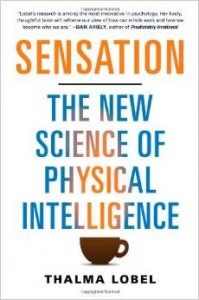 Like many people in the business of “human” resources, I’ve always been fascinated by what makes people tick — especially in the workplace. That’s why the book, Sensation: The New Science of Physical Intelligence by Professor Thalma Lobel was a fascinating read. The author explores how our personal and professional behavior and decision-making are influenced by the physical stimuli that we’re exposed to everyday.
Like many people in the business of “human” resources, I’ve always been fascinated by what makes people tick — especially in the workplace. That’s why the book, Sensation: The New Science of Physical Intelligence by Professor Thalma Lobel was a fascinating read. The author explores how our personal and professional behavior and decision-making are influenced by the physical stimuli that we’re exposed to everyday.
From taste to smell to touch and beyond, this book’s sweeping exploration makes sense of the senses. Through various research projects we learn thought-provoking new insight that has many implications for HR professionals.
If you have intellectual curiosity about psychology, physiology, and how it all affects work behavior, try putting the book’s findings into these real-world work scenarios!
- Hold a warm cup of coffee during an interview. A study found that we perceive people differently — in fact, more favorably — when we are holding a warm beverage as opposed to a cold one.
- Smell a cinnamon candle or fresh baked sweets while training or rallying coworkers. Did you know that the scent of cinnamon improves memory and attention, and sweet smells enhance helpful behavior and altruism? Research proves it!
- Turn on a light bulb during a brainstorming session. The author reveals experimental findings regarding creativity and innovation. These vital characteristics can actually be enhanced by replacing florescent lighting with good, old fashioned light bulbs. Furthermore, subjects perform better with bare bulbs than with those that are shaded!
- Offer a soft chair when negotiating a new-hire package. Did you know that “hard objects increase(d) rigidity in negotiation.” Researchers found a significant difference in intensity between subjects sitting in hard and soft chairs.
- Attach a stack of resumes to a hefty clipboard. The importance of “a thing” is often subconsciously judged by its physical weight. In a research experiment, participants received the same resume. Half of the group had the resume attached to a lightweight clipboard and the other half had the same resume attached to a heavier clipboard. The second group rated the candidate as better qualified and with more interest in the job.
- Design workplace signage (such as safety messages) with a vertical layout. It appears that it is easier to get a reader’s attention when the words in a document are laid out vertically. In fact, the author’s findings reveal that there are many physical factors in reading material, besides syntax and sentence structure — like text size, position, and color — that influence readers.
By applying this book’s findings in a variety of business setting, HR professionals — not to mention managers, job candidates, and employees — could have more control and understanding of how their external stimuli influences personal and professional behavior. This knowledge may very well help readers improve their professional standing.